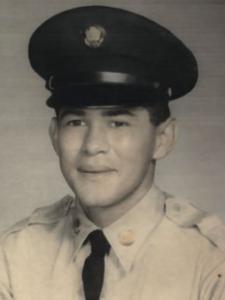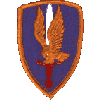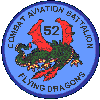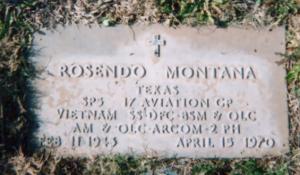| |
|
|
|
Rosendo Montana
Specialist Five
SECURITY PLT, HHC, 52ND AVN BN, 17TH AVN GROUP, 1ST AVIATION BDE, USARV Army of the United States Big Spring, Texas February 11, 1943 to April 15, 1970 ROSENDO MONTANA is on the Wall at Panel W11, Line 8 See the full profile or name rubbing for Rosendo Montana |

   |

|



| |
|
Rosendo was a career soldier from Big Spring, Texas. He was married to Marie Montana and had been in the Army since 1964. He had completed a previous tour in Vietnam in 66-67. Rosendo was a Pathfinder and was apart of the security detachment for the 17th Aviation Group. On April 15, 1970, Rosendo was shot to death when he was a part of a planned insertion of ARVN troops into LZ Orange to counter buildup of NVA troops around a Special Forces camp at Dak Seang, about 20 miles north of Dak To. He was the radio operator and was with another American soldier and a handful of ARVN troops who were the first group to be inserted and as such were setting up security for the insertion of additional ARVN troops when suddenly the second helicopter coming in for insertion was hit from all sides with ground fire. The helicopter was shot down. Specialist Montana was wounded in the concentration of ground fire and he continued to try to get out radio transmissions dispite his wounds. He was then killed as the second barrage was concentrated on his position. Specialist Montana was buried with full military honors in Big Spring, Texas, and is remembered on the Permian Basin Vietnam Veterans' Memorial.
|
Notes from The Virtual WallThe situation at Dak Seang was a little more complicated than described above. The Special Forces camp at Dak Seang was under attack and a decision was taken to insert the 3rd Bn, 42nd ARVN Regiment, onto a bit of high ground about a mile distant from the camp in order to relieve pressure on the SF camp. As noted, the 170th AHC was tasked with the insertion. Although NVA forces essentially surrounded the proposed landing zone they were invisible within camoflaged bunkers - and when they allowed the first Huey to land unopposed it appeared the insertion was into a "cold" LZ.The first Huey landed two US pathfinders (SP5 Rosendo Montana and Cpl Herndon A. Bivens) and six ARVN troops. The second Huey, UH-1H tail number 68-16203, was shot down, landing in the middle of the LZ. Although two ARVN soldiers died in the crash, four US aircrewmen and four ARVN soldiers suffered only minor injuries and were able to exit the wrecked aircraft. The pilot, WO Albert L. Barthelme, was severely wounded as he exited but was carried to a nearby bomb crater. Copilot WO Roger A. Miller, crewmen SP4 Vincent S. Davis and SP5 Donald C. Summers, and four ARVNs were with Barthelme; the surviving soldiers from the first Huey were a short distance away. All were taking heavy fire from the NVA defenders. Immediate efforts at extraction were hampered by three factors:
Two unladen 170th AHC Hueys then arrived on scene. One of them, piloted by a WO Bill McDonald, landed under heavy fire and was able to take crewmen SP4 Davis and SP5 Summers from UH-1H 68-16203 aboard before being forced from the LZ. Although McDonald's aircraft was badly shot up, he was able to nurse it to just within the Special Forces camp perimeter. The second UH-1 landed next to McDonald, made an under-fire transfer of the men from McDonald's aircraft, and lifted off with a load of wounded men. At this point Davis and Summers advised that one of the US pathfinders was dead and WO Barthelme severely wounded. By this time night was falling, the Special Forces camp was under active attack, and there was no realistic hope for further efforts to extract the US and ARVN troops on the hilltop. During the night, some of the ARVNs decided to try to get to the SF camp; two made it. Miller and Bivens elected to stay close to the Huey wreckage with WO Barthelme, who could not be moved, and await the morning's events. Renewed airborne SAR efforts were begun at first light, but to no avail - none of the missing US or ARVN troops could be located. Friendly ground forces could not reach the LZ until 29 April 1970, when they found and recovered the bodies of WO Barthelme and SP5 Montana. There was no trace of WO Miller or CPL Bivens. In time some of the questions were resolved. WO Miller had been captured, survived captivity, and was released by the NVA on 05 March 1973. On his return he advised that after Barthelme died during the night, he and Bivens decided to try for friendly lines but were ambushed while enroute. Bivens was hit in the chest by a half-dozen rounds, and Miller was told that Bivens died about two hours after they were captured. All told, two US infantrymen, eight US aircrewmen, and twelve ARVN infantrymen had been on the ground. Only six survived the experience:
|
| Contact Us | © Copyright 1997-2019 www.VirtualWall.org, Ltd ®(TM) | Last update 08/15/2019. |
